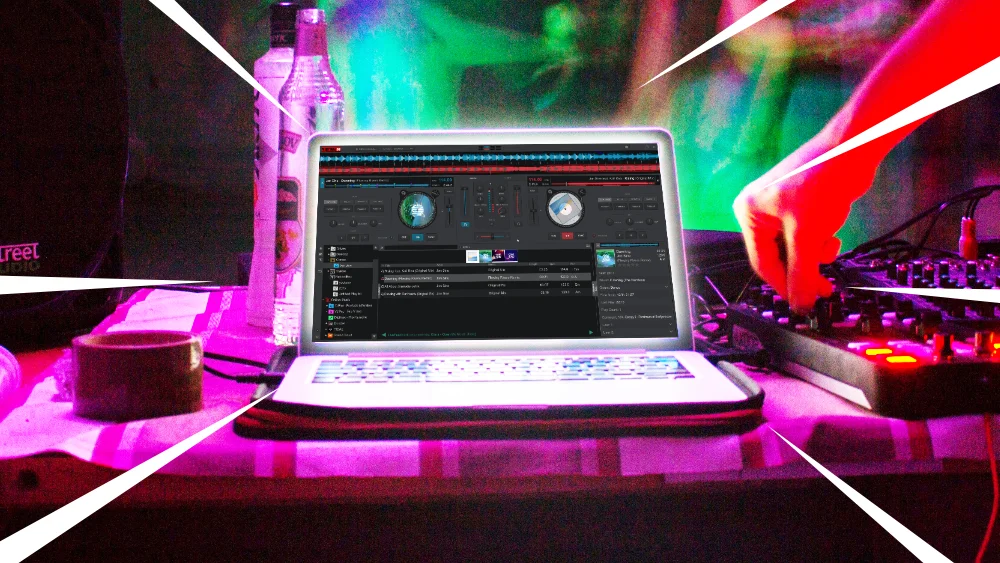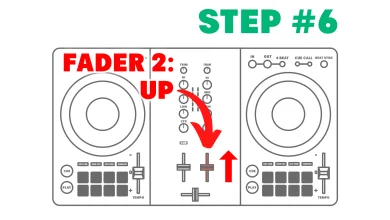Song structure for DJs – with examples & schematics
When you start DJing, it is very useful to know the structure of a EDM song, also called song arrangement.
Every song consists of building blocks that vary to make the song more interesting.
When you know the structure of a song, you can anticipate on that by using key moments of a song as mix-out or mix-in point
Building blocks
Here are the building blocks for an EDM track.
EDM music producers often use different names than songwriters (plebs), that’s because we EDM producers think we are better 😉
| EDM name | Also known as | Energy level |
|---|---|---|
| Drop | Chorus | ++ |
| Break | Verse | — |
| Buildup | Pre-chorus | — → ++ |
| Bridge | Bridge | +- |
| Intro | Intro | +- |
| Outro | Outro | +- |
Drop

This is the recurring theme of the song, the most recognizable part, the part that repeats.
A song can have 2, 3 or 4 drops.
This is the melody that people know when they hum the song.
The drop is also the loudest part of the song and it needs the be the most fun and appealing part of
the song.
The break is quieter and has fewer elements (most of the time).
The drop is the most bass heavy, as where the break is mostly less bass heavy.
Some genres of electronic music don’t have a clear distinction between break and drop, like in a
lot of techno and tech house songs.
They do have recurring themes, so you could consider those a drop.
Most of the time they change up quieter and louder parts , you could consider those a break
Break

The break (verse) is the quiet part of the song (tempo often stays the same).
The melody is different than the drop.
In pop, the melody is often the same, but the lyrics are different.
In EDM, the melody is often different for each break.
The break is often announced by a very distinctive bass drop.
Buildup

The buildup is often called the pre-chorus: it prepares and gets you excited for the drop.
You know it’s coming … just a little bit … just wait … it’s coming … yes …. here we are …. BOOM, here’s the drop.
Some see the buildup part of the break.
Whatever floats your boat, it gives the listener a clear indication of what is coming up.
It builds an expectation.
There can also be a gap of a full bar between the buildup and the drop, just to make the impact
of the drop even bigger (the power of silence).
A typical buildup has the following elements:
- repeating a melody or repeating a part of the melody
- the snare sounds that become more frequent over the course of the buildup
- A riser (white noise, melodic or both)
- low cut filter
Bridge
The bridge is uncommon in EDM tracks, but they do exist.
A bridge has a different melody than the break and drop to change things up, and make the song less boring.
The bridge appears only once in a song, mostly between 2 drops at the end.
Intro

The intro is the beginning of the song.
It often introduces new musical elements with each block of bars (like a thicker beat, an extra high hat etc).
The intro is a common mix-in point for DJs.
Outro

The outro is the end of a song.
It takes away elements of a song with each block of bars.
The outro is a common mix-out point for DJs.
Free DJ tips in your inbox?
As a bonus gift I will send you a FREE E-book on how to kick-off your DJ career!
The order and length of song elements

Since 2005 EDM tracks started to have a standard structure, so it is really easy for DJs to understand the structure, so they can easily mix it with a track of a similar structure.
Since then we have a fixed length of block.
The smallest form of a block is 4 bars (often 8).
The rest is a multiplication of 4.
Here is the most commonly used song structure with their length in bars:
| Block | Bar length | Length 128 BPM |
|---|---|---|
| Intro | 16 or 32 bars | 30 or 60 sec. |
| 1st break | 16 or 32 bars | 30 or 60 sec. |
| 1st buildup | 8 bars | 15 sec. |
| 1st drop | 16 or 32 bars | 30 or 60 sec. |
| 2nd break | 16 or 32 bars | 30 or 60 sec. |
| 2nd buildup | 8 bars | 15 sec. |
| 2rd drop | 16, 32 or 48 bars | 30, 60 or 90 sec. |
| outro | 16 or 32 bars | 30 or 60 sec. |
Notes:
- Notice that there is no Bridge in this example.
- There can be a 3rd break-buildup-drop pair
- This is by no means a definitive structure, the order and length can vary (but the 8-bar rule still applies).
- There are also structural differences between genres: Electro House has a different structure than Techno for example.
Techno often lacks buildups for example. - Tracks that are written for Spotify, often have no break and start immediately with a drop, because the youth has a very short attention span.
- 128 BPM the block-sizes are exactly 30 seconds (4 beats in a bar x 32 bars = 128 BPM = 60 secs)!
If your song is 126 BPM for example, it is slightly more than 30 seconds
If your song is 130 BPM for example, it is slightly less than 30 seconds.
Radio edits and club mixes
There are generally 2 types of tracks:
- Extended mix / club mix / original mix – has intro and outro
- Radio edit – has NO intro and outro
As a DJ having an intro and outro makes you like a lot easier to make smooth transitions.
You want to have tracks with intros and outros.
Most commercial tracks you stream or down from commercial stores (Spotify or Apple music) are often radio edits.
When you download or stream from DJ pools/webshops: they often offer extended mixes for DJs.
Look at the waveform
Luckily for us DJs, DJ equipment and software shows us the waveform of a song.
Just by looking at it, you can distinguish the different block elements.
This is a tech house song without build-ups (click to enlarge):

Free DJ tips in your inbox?
As a bonus gift I will send you a FREE E-book on how to kick-off your DJ career!
Song structure examples
Let’s take a look at some examples and do an autopsy on each track.
I use some classics, because everybody knows them (I hope).
Martin Garrix – Animals
| Block | Bar length | Length 128 BPM |
|---|---|---|
| Intro | 32 bars | 60 sec. |
| 1st break | 20 bars | |
| 1st buildup | 8 bars | 15 sec. |
| 1st drop | 16 bars | 30 sec. |
| 2nd break | 20 bars | |
| 2nd buildup | 8 bars | 15 sec. |
| 2rd drop | 24 bars | |
| outro | 32 bars | 60 sec. |

Genre: electro house/ big room, 128 BPM
Electro house always has a clear distinction between the different elements.
You can see and hear where elements begin and end.
There is a clear intro, a very distinctive low energy break, and a super high energy drop.
The song is 128, so it abides beautifully to our 30 second-rule (albeit sometimes double, sometimes half).
Alex Niggemann – Materium
| Block | Bar length | Length |
|---|---|---|
| Intro | 88 bars | – |
| 1st break | 36 bars | – |
| 1st buildup | [buildup??] | – |
| 1st drop | 32 bars | – |
| 2nd break | 32 bars | – |
| 2nd buildup | [none] | – |
| 2rd drop | 16 bars | – |
| outro | 40 bars | – |

Genre: tech house, 120 BPM
This has one of those unconventional structures, this is the reason why I included it here, so I can show you some of the exceptions.
Where some elements begin and others end, is maybe up for debate.
If you don’t agree with my analysis I would completely understand why.
- This song has a huge-ass long intro, to the point that it almost isn’t funny anymore.
I counted it as an intro (and not a drop), because there were not a lot of melodic elements in the intro. - A clear break with absolute silence
- A whiny buildup that you could maybe count as buildup (I didn’t here).
- A drop
- A break that ends with a beat (very strange)
- A pretty short drop
- And again a huge-ass outro of a weird 40 bars.
The song is incredibly boring when you listen to it at home.
On the dancefloor at 100dB however, is another story!
You can dream away and forget about the world.
Calvin Harris & Alesso – Under control
| Block | Bar length | Length 126 BPM |
|---|---|---|
| Intro | 24 bars | |
| 1st break | 4 bars | |
| 1st buildup | 4 bars | |
| 1st drop | 8 bars | ± 15 sec. |
| 2nd break | 28 bars | |
| 2nd buildup | 8 bars | ± 15 sec. |
| 2rd drop | 16 bars | ± 30 sec |
| outro | [none] |

Genre: Electro house/pop, 126 BPM
Here an extremely sucky track to mix in and out (click to enlarge).
In the entire intro is a vocal, a drop at the end with vocal, and there is no outro (sorry, the included YouTube version has an outro, but not my version).
The version I have is a radio edit (not a club mix/extended mix).
- The intro is pretty long
- The 1st break is super short with 4 bars
- The 1st buildup is also short with 4 bars
- The 1st drop is also pretty short with 8 bars
- The 2nd break is super long
- The 2nd buildup is twice as long as the first one
- The 2nd drop is 16 bars
- The YouTube video has an outro, my radio edit doesn’t



